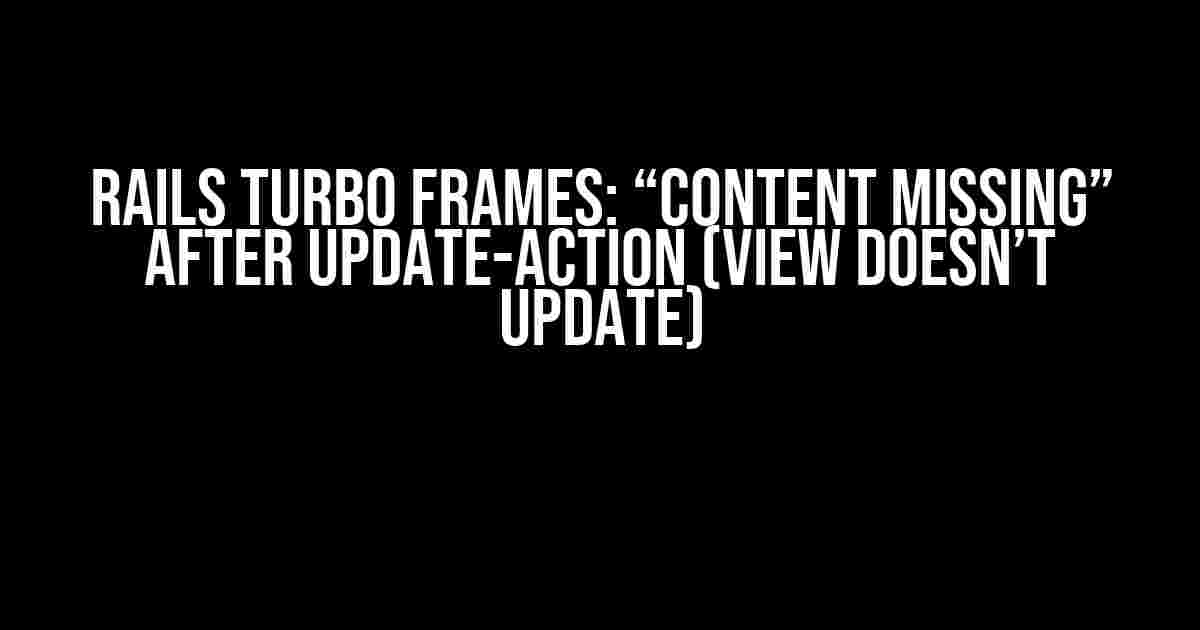Are you tired of encountering the frustrating “Content missing” error in your Rails app after an update action? Do you find yourself wondering why your view refuses to update despite following the Turbo Frames documentation to the letter? Fear not, dear developer, for we’ve got you covered!
What are Turbo Frames?
Before we dive into the solution, let’s take a step back and understand what Turbo Frames are. Turbo Frames is a built-in feature in Rails 7+ that allows you to easily create fast, seamless, and interactive web applications. It achieves this by turning HTML pages into Turbo Drive applications, enabling swift page loads, and reducing the need for full page reloads.
The “Content missing” Conundrum
Now, back to our problem at hand. When you update a resource using Turbo Frames, you might encounter the “Content missing” error, where the updated content isn’t reflected in the view. This can be particularly frustrating when you’ve followed the Turbo Frames documentation and tutorials to the letter.
Why Does this Happen?
Before we can fix the issue, it’s essential to understand why it happens in the first place. The “Content missing” error typically occurs when:
- The updated content is not properly wrapped in a Turbo Frame.
- The Turbo Frame ID doesn’t match the ID of the element being updated.
- The update action doesn’t correctly trigger a Turbo Frame update.
- There’s a mismatch between the Turbo Frame and the rendered partial.
Solving the “Content missing” Error
Now that we’ve covered the whys, let’s dive into the solutions. Follow these steps to ensure your Turbo Frames update correctly:
1. Verify Turbo Frame Wrap
Make sure the updated content is wrapped in a Turbo Frame. The Turbo Frame should have a unique ID, which will be used to target the update.
<turbo-frame id="my_frame"> <%= render 'my_partial' %> </turbo-frame>
2. Ensure Turbo Frame ID Match
Verify that the Turbo Frame ID matches the ID of the element being updated. In your controller, use the `update` method to update the Turbo Frame with the correct ID.
def update
# Update the resource
respond_to do |format|
format.turbo_stream do
render turbo_stream: turbo_stream.update('my_frame', partial: 'my_partial')
end
end
end
3. Correctly Trigger Turbo Frame Update
Ensure that the update action correctly triggers a Turbo Frame update. Use the `turbo_stream.update` method to update the Turbo Frame.
def update
# Update the resource
respond_to do |format|
format.turbo_stream do
render turbo_stream: turbo_stream.update('my_frame') do |stream|
stream.update('my_frame', partial: 'my_partial')
end
end
end
end
4. Turbo Frame and Partial Rendering
Verify that there’s no mismatch between the Turbo Frame and the rendered partial. Ensure that the partial is correctly rendered and matches the Turbo Frame ID.
<turbbo-frame id="my_frame">
<%= render partial: 'my_partial', locals: { resource: @resource } %>
</turbo-frame>
Bonus Tips
Here are some additional tips to keep in mind when working with Turbo Frames:
- Use the `turbo_frame_tag` helper to generate a Turbo Frame.
- Avoid using `render layout: false` in your controllers, as it can interfere with Turbo Frames.
- Verify that your Turbo Frames are properly nested, as deeply nested Turbo Frames can lead to issues.
- Use the `turbo_stream.replace` method to replace the entire contents of a Turbo Frame.
Conclusion
With these solutions and bonus tips, you should be well on your way to resolving the “Content missing” error in your Rails app. Remember to double-check your Turbo Frame wrap, ID matches, update triggers, and partial rendering. By following these guidelines, you’ll be creating seamless, interactive, and fast web applications in no time!
| Turbo Frames Best Practices |
|---|
| Wrap updated content in a Turbo Frame. |
| Verify Turbo Frame ID matches the ID of the element being updated. |
| Correctly trigger Turbo Frame updates using the update method. |
| Avoid mismatches between Turbo Frames and rendered partials. |
By following these best practices and troubleshooting steps, you’ll be able to resolve the “Content missing” error and create rich, interactive web applications with Turbo Frames. Happy coding!Here are 5 Questions and Answers about “Rails Turbo Frames: “Content missing” after Update-action (View doesn’t update)” in HTML format:
Frequently Asked Question
Are you stuck with Rails Turbo Frames and wondering why your view doesn’t update after an update action?
What causes the “Content missing” error in Rails Turbo Frames after an update action?
This error typically occurs when Turbo Frames can’t find the updated content in the response. It’s often due to the server not returning the correct headers or the frame not being properly defined in the view.
How can I troubleshoot the “Content missing” error in Rails Turbo Frames?
To troubleshoot, check the server response in the browser’s dev tools to ensure the correct headers are being sent. Also, verify that the frame is properly defined in the view and that the updated content is being rendered correctly.
What is the purpose of the `turbo_frame_tag` helper in Rails?
The `turbo_frame_tag` helper is used to define a Turbo Frame in the view, which enables Turbo to update the content of that frame when a request is made.
How can I ensure that my Turbo Frame is properly updated after an update action?
To ensure proper updating, make sure to include the `turbo_frame_tag` helper in your view, and that the server returns the updated content with the correct headers. You can also use the `turbo_stream` helper to stream updates to the frame.
Are there any common pitfalls to avoid when using Rails Turbo Frames?
Yes, common pitfalls include not defining the frame properly, not returning the correct headers, and not ensuring that the updated content is rendered correctly. Additionally, not handling errors and exceptions properly can also lead to issues.
I hope this helps! Let me know if you need any further assistance.
